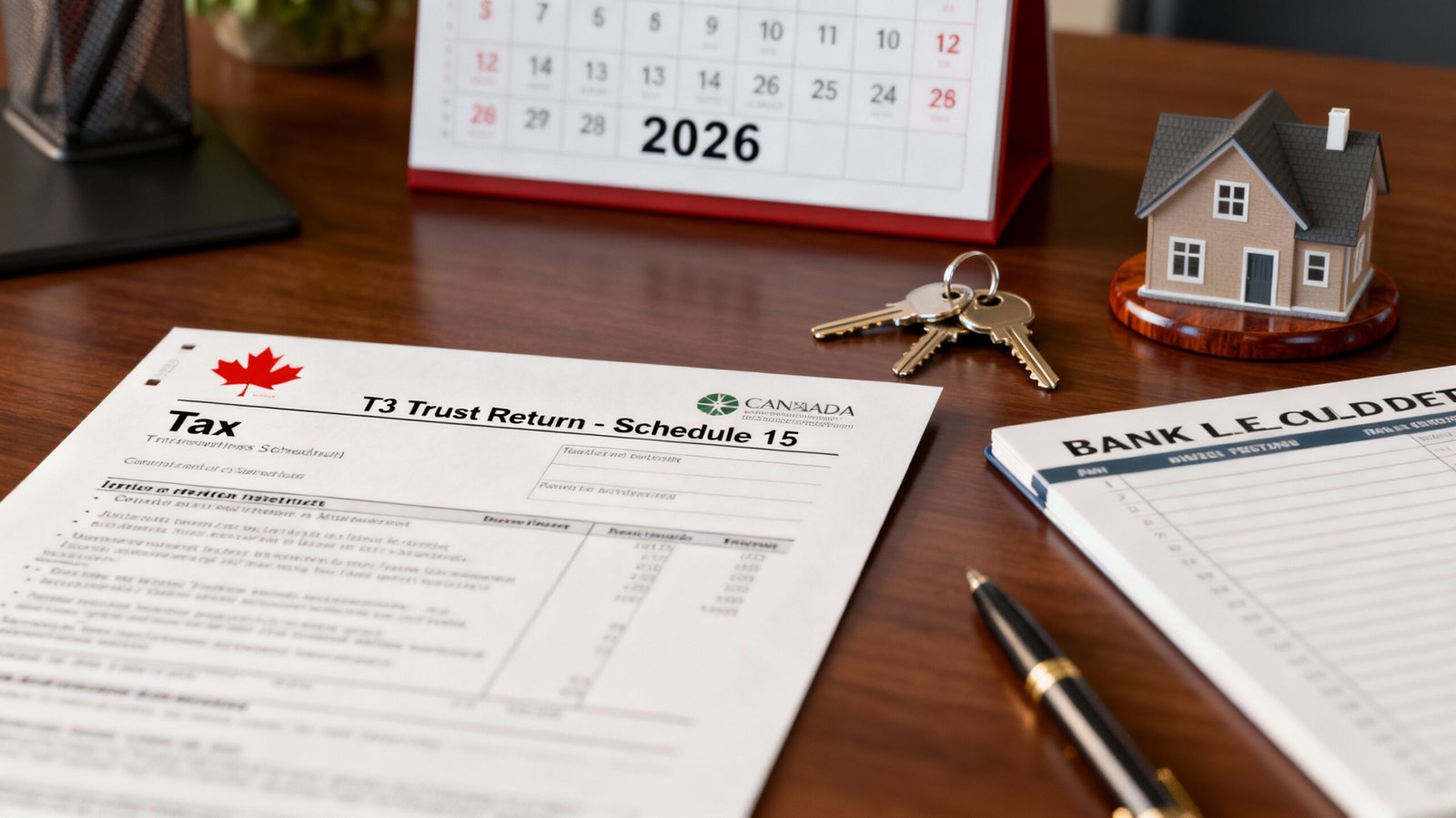Understanding Business Income Tax Reporting Requirements
Business income tax reporting in Canada is a critical obligation for all Canadian business owners, entrepreneurs, and self-employed professionals. Whether you operate as a sole proprietor, manage a partnership, or run an incorporated company, understanding your tax filing requirements and deadlines is essential for maintaining compliance with the Canada Revenue Agency (CRA) and avoiding costly penalties.
The Canadian tax system requires different reporting methods depending on your business structure. Sole proprietors file through personal income tax returns, partnerships use T5013 information returns, and corporations file T2 corporate tax returns. Each structure has unique requirements, deadlines, and optimization opportunities that can significantly impact your bottom line.
Business Structure Types and Their Tax Obligations
Sole Proprietorships and Self-Employment Income
If you earn income from self-employment, freelancing, consulting, or running an unincorporated business, the CRA classifies you as self-employed. This classification applies to professionals, commission salespeople, gig economy workers, and business owners operating without incorporation.
Self-employed individuals must report all business income on Form T2125 (Statement of Business or Professional Activities) as part of their personal T1 income tax return. This form requires you to report total business revenue and deduct all eligible business expenses to calculate your net income.
Self-employed individuals generally must use a December 31 year-end for tax purposes, though eligible individuals can elect to use another fiscal period by completing Form T1139. This election requires specific conditions to be met and must be requested in writing.
The filing deadline for self-employed individuals is June 15 if either you or your spouse/common-law partner is self-employed. However, any balance owing remains due by April 30. This distinction is important because many self-employed individuals can file late without penalty as long as they file by June 15, though interest still accumulates on unpaid balances.
Partnership Tax Reporting
Partnerships in Canada operate as pass-through entities, meaning the partnership itself does not pay income tax. Instead, income flows through to individual partners, who report their share on their personal or corporate tax returns.
However, partnerships meeting certain thresholds must file a T5013 Partnership Information Return with the CRA. This requirement applies when the combined absolute value of revenue and expenses exceeds two million dollars, assets exceed five million dollars, or when one partner is a corporation or another partnership.
For partnerships with all individual partners and revenue below these thresholds, the filing deadline for T5013 returns is March 31. For partnerships with at least one corporate or partnership member, the deadline is the earlier of March 31 or five months after the fiscal year-end.
Each partner receives a T5013 Statement of Partnership Income that details their share of income, expenses, deductions, and credits. Partners then report this information on their personal or corporate tax returns.
Corporation Income Tax Filing
All resident corporations in Canada must file an annual T2 Corporation Income Tax Return, regardless of whether they earned income, incurred losses, or operated as a dormant entity. This requirement applies to active businesses, non-profit organizations, tax-exempt corporations, and inactive corporations.
The T2 return is a complex filing that includes multiple schedules and requires reconciliation of accounting income with taxable income. Corporations report business income, calculate deductions, and determine tax liability on this comprehensive form.
For tax years beginning after 2023, almost all corporations must file electronically with CRA. The mandatory electronic filing requirement applies to resident corporations, with limited exceptions for insurance corporations, non-resident corporations, corporations reporting in functional currency, and certain tax-exempt entities. The CRA charges a one-thousand-dollar penalty for failure to file electronically when required.
Accounting Methods: Accrual vs. Cash Basis
Understanding Accounting Methods
The accounting method you use determines when you report income and deduct expenses. This choice has significant implications for your tax liability and cash flow management.
The CRA generally requires businesses to use the accrual method of accounting for tax purposes. Under accrual accounting, you report income when earned (regardless of when payment is received) and deduct expenses when incurred (regardless of when payment is made).
Cash basis accounting, by contrast, reports income only when received and deducts expenses only when paid. This method provides a simpler accounting approach but less accurate financial reporting.
Eligibility for Cash Basis Accounting
Only specific types of businesses can use the cash method of accounting. Eligible entities include farming operations, fishing businesses, and self-employed commission agents. These exceptions exist because of the unique nature of these industries and their seasonal income patterns.
Most other business types, including corporations, professional practices, retail operations, and service businesses, must use accrual accounting. If your business doesn’t qualify for cash accounting and you’re using it, the CRA can reassess your returns and require conversion to accrual basis.
Why Accrual Accounting Matters
Accrual accounting provides accurate financial reporting by matching revenue with related expenses in the same period. This method aligns with Generally Accepted Accounting Principles (GAAP) and creates financial statements that truly reflect business performance.
For tax purposes, accrual accounting also prevents artificial income deferral by requiring income recognition when earned, regardless of collection status. Similarly, it prevents artificial expense acceleration by requiring expense deduction when incurred, not when paid.
Fiscal Year Requirements and Election Options
Fiscal Year-End Selection for Corporations
A corporation’s fiscal period is its tax year and cannot exceed fifty-three weeks or three hundred seventy-one days. A new corporation can choose any tax year-end as long as its first fiscal period doesn’t exceed fifty-three weeks from incorporation.
Common fiscal year-end choices include December 31 (aligning with the calendar year), March 31 (common for businesses structured around school or academic calendars), or May 31 (popular for businesses with seasonal revenue patterns).
Once established, changing the fiscal year-end requires CRA approval. Most changes require completing a formal request and providing business justification for the change.
Self-Employed Fiscal Period Requirements
Self-employed individuals and sole proprietors generally must use a December 31 calendar year-end for tax purposes. This standardized year-end simplifies tax administration and ensures consistency across personal tax filings.
If you want to elect a non-calendar fiscal period as a self-employed individual, you must complete Form T1139 to reconcile your business income for tax purposes. This election allows you to use a fiscal period ending on a day other than December 31, though the CRA has significant discretion over approval.
Filing Deadlines and Payment Timelines
Corporate Tax Return Filing and Payment Deadlines
Corporations must file their T2 return within six months of their fiscal year-end. The specific deadline depends on when your fiscal year ends. If your fiscal year-end falls on the last day of a month, the return is due by the last day of the sixth month after year-end. For year-ends on other days, the return is due on the same day of the sixth month following year-end.
For example, a corporation with a December 31, 2024 fiscal year-end must file its T2 return by June 30, 2025.
However, while you have six months to file your return, any taxes owing must be paid much sooner. Corporations must pay their tax balance by the earlier of: two months after the fiscal year-end (three months for Canadian-Controlled Private Corporations that qualify for the small business deduction), or the filing deadline.
For the same December 31, 2024 example, the tax payment deadline would be February 28, 2025 for most corporations or March 31, 2025 for qualifying CCPCs. This means you could file your complete return by June 30 but must pay the tax owing by February or March.
Self-Employed Tax Return Filing Deadlines
Self-employed individuals must file their personal income tax returns by June 15 if either they or their spouse/common-law partner earn self-employment income. However, any balance owing remains due by April 30.
This June 15 filing deadline provides a grace period for self-employed filers compared to other individual taxpayers, who must file by April 30. However, interest accrues daily on any unpaid tax from April 30 onward, even if you don’t file until June 15.
Electronic Filing Requirements
For tax years beginning after 2023, corporations must file electronically. This requirement applies to all T2 filings, with limited exceptions for specific corporation types and circumstances.
Electronic filing can be completed through multiple channels, including CRA NETFILE, software providers certified by CRA, or tax professionals authorized to file electronically. The CRA charges a significant penalty for failure to file electronically when required.
Required Tax Forms and Schedules
Form T2125 for Self-Employed Individuals
Form T2125 (Statement of Business or Professional Activities) is the primary tax form for self-employed individuals and sole proprietors. This form requires you to report business identification information, calculate gross income, deduct business expenses, and determine net business income.
The T2125 form includes sections for reporting various types of business income including sales revenue, commissions, fees, and other business income. It requires itemization of common business expenses in categories such as advertising, supplies, rent, utilities, insurance, and professional fees.
If you operate multiple distinct business activities, you must file a separate T2125 for each business. This separation ensures proper income allocation and allows the CRA to track income by business type.
T2 Corporation Income Tax Return and Schedules
The T2 return package is comprehensive and includes multiple required schedules. All corporations must file at minimum:
Schedule 100 reports balance sheet information including assets, liabilities, and equity as of the fiscal year-end. Schedule 125 captures income statement information including revenue, expenses, and net income. Schedule 141 includes notes checklist identifying which financial statement notes were prepared.
Additional schedules required based on specific circumstances include Schedule 1 (Net Income for Income Tax Purposes), which reconciles accounting profit with taxable income. Schedule 24 must be completed by first-time filers. Schedule 50 reports shareholder information for private corporations.
General Index of Financial Information (GIFI) codes represent financial statement accounts in a standardized format required by CRA for electronic filing and data analysis.
T5013 Partnership Information Return
Partnerships meeting filing thresholds must submit comprehensive T5013 returns including partnership identification and business information, statement of partnership income or loss, each partner’s share of income and expenses, and balance sheet information if applicable.
Each partner receives a T5013 Statement of Partnership Income detailing their specific share of all income items, deductions, credits, and other relevant tax information. Partners then report this information on their individual or corporate tax returns.
Deductible Business Expenses and Limitations
Categories of Deductible Business Expenses
The CRA allows deduction of reasonable current expenses incurred to earn business income. Common deductible expenses include advertising and promotion, business taxes and licenses, office supplies, business rent, telephone and utilities, insurance, professional fees such as accounting and legal services, and salaries and wages.
Additional deductible categories include bank charges and interest on business loans, delivery and freight charges, office equipment purchases, research expenses, subscriptions to professional journals, and internet and computer services.
Expense Documentation Requirements
All business expenses must be supported by original source documents including invoices, receipts, bank statements, and supporting records. The CRA requires retention of these documents for a minimum of six years from the end of the tax year they relate to.
Detailed record-keeping is essential because the CRA conducts audits and may disallow deductions lacking proper documentation. For vehicle expenses, you must maintain logs showing dates, destinations, kilometers traveled, and business purposes for each trip claimed.
Special Expense Considerations
Meals and entertainment expenses face specific limitations with only fifty percent of costs generally deductible. This means if you spend one hundred dollars on a client meal, only fifty dollars can be deducted as a business expense.
Motor vehicle expenses require calculation of the business-use percentage based on business kilometers divided by total kilometers driven. Only the business-use portion of fuel, maintenance, insurance, and depreciation can be deducted.
Home office expenses can be deducted for the business-use portion of your residence. This is calculated by dividing the square footage of the office space by the total square footage of your home and applying this percentage to eligible home expenses like rent, utilities, insurance, and maintenance.
Personal expenses are never deductible. An expense cannot be claimed if it has personal use components unless the business-use percentage is documented and properly allocated.
Capital Cost Allowance: Depreciating Business Assets
Understanding Capital Cost Allowance
Capital assets providing value over multiple years cannot be fully deducted in the year of purchase. Instead, you claim Capital Cost Allowance (CCA)—a tax deduction that spreads the cost over the asset’s useful life.
Examples of capital assets include buildings, vehicles, furniture, computers, machinery, equipment, and goodwill. Most capital assets must be depreciated through CCA claims rather than expensed directly.
CCA Classes and Depreciation Rates
Assets are grouped into classes with prescribed depreciation rates established by the Income Tax Act. Different classes have different depreciation rates reflecting the assets’ expected useful lives.
Class 1 assets including buildings depreciate at four to six percent annually. Class 8 assets including furniture and office equipment depreciate at twenty percent. Class 10 assets including vehicles depreciate at thirty percent. Class 14.1 assets including goodwill and intangible assets depreciate at five percent. Class 50 assets including computer hardware and software depreciate at fifty-five percent.
The correct classification is important because using the wrong class can result in incorrect CCA calculations and tax reassessments.
The Half-Year Rule
In the first year of purchase, you can only claim fifty percent of the normal CCA amount on a particular asset. This half-year rule accounts for assets not being in use for the full year.
For example, if you purchase equipment costing ten thousand dollars in Class 8 (twenty percent depreciation rate), you would normally deduct two thousand dollars (ten thousand times twenty percent). However, with the half-year rule, you deduct one thousand dollars in the first year (ten thousand times twenty percent times fifty percent).
Calculating Undepreciated Capital Cost
Undepreciated Capital Cost (UCC) represents the remaining balance in a CCA class that hasn’t been deducted. This is your starting point for CCA calculations each year.
The UCC calculation begins with opening balance, adds acquisitions of new assets, subtracts proceeds from asset disposals, and applies the half-year rule to net additions. The result is the balance available for depreciation.
Understanding UCC is essential for accurate CCA calculations because depreciation applies to the UCC balance, not individual asset costs.
Inventory Valuation and Cost of Goods Sold
Conducting Inventory Counts
If you sell physical products, you must conduct a physical inventory count at fiscal year-end. This count identifies all inventory on hand including raw materials, work-in-progress, and finished goods.
The inventory count must be documented with quantities and descriptions. Inventory that is damaged, obsolete, or unsaleable must be identified separately for potential writedown.
Inventory Valuation Methods
The CRA accepts two inventory valuation methods. The first is fair market value of your entire inventory. The second is the value of individual items or classes at the lower of cost or fair market value.
The lower of cost or fair market value method is more commonly used. Under this approach, each inventory item is valued at its historical purchase cost, but if the current fair market value is lower, the lower value is used.
Calculating Cost of Goods Sold
The Cost of Goods Sold (COGS) formula is: Opening Inventory plus Purchases or Production Costs minus Ending Inventory equals COGS.
For example, if you started the year with five thousand dollars in inventory, purchased forty thousand dollars in inventory during the year, and ended with six thousand dollars in inventory, your COGS would be thirty-nine thousand dollars (five thousand plus forty thousand minus six thousand).
Proper inventory valuation is crucial because COGS directly impacts net income calculation. Overstating inventory reduces COGS and overstates income, while understating inventory increases COGS and understates income.
GST and HST Registration and Compliance
GST/HST Registration Thresholds
You must register for Goods and Services Tax (GST) or Harmonized Sales Tax (HST) when your taxable supplies exceed thirty thousand dollars in any single calendar quarter or over four consecutive quarters.
Once you exceed the threshold, you must register within thirty days. Registration is retroactive to when you first exceeded the threshold, meaning you become liable for GST/HST on all sales from that point forward, even if you haven’t yet registered.
Associated Companies Registration Rules
If your business is associated with other companies already registered for GST/HST, the thirty-thousand-dollar threshold is shared among all associated entities. This means if you have multiple associated businesses collectively exceeding the threshold, each business must register regardless of individual revenues.
Associated businesses include corporations controlled by the same person, corporations where one entity owns more than fifty percent of another, and other related entities. Careful analysis of association status is essential for determining GST/HST obligations.
Voluntary Registration
Businesses below the registration threshold can register voluntarily for GST/HST. Voluntary registration allows you to collect GST/HST on sales and claim input tax credits on business expenses, potentially resulting in net recoveries of tax paid.
Voluntary registration is advantageous for businesses with significant business expenses, since input tax credits can exceed GST/HST collected. However, once you register, you generally must remain registered for two years.
Corporate Tax Rates and Small Business Deductions
Federal Corporate Tax Rates
The federal corporate income tax rate is fifteen percent on general corporate income. However, Canadian-Controlled Private Corporations (CCPCs) qualify for a small business deduction reducing the federal rate to nine percent on the first five hundred thousand dollars of active business income earned annually.
The small business deduction is one of the most valuable tax incentives for Canadian private corporations and can result in significant tax savings.
Provincial and Combined Rates
When combined with provincial rates, the effective tax rate on small business income varies by province. In Alberta and British Columbia, the combined small business rate is approximately eleven percent. In Ontario and Quebec, combined rates are approximately twelve to twelve-point-two percent. In Manitoba and Saskatchewan, combined rates are approximately nine to nine-point-five percent.
The provincial variation is significant and should factor into business location decisions and tax planning strategies.
Small Business Deduction Eligibility
The small business deduction applies to Canadian-Controlled Private Corporations earning active business income. Active business income includes revenue from providing products or services. Passive income such as interest, dividends, and capital gains generally does not qualify for the small business deduction.
The five-hundred-thousand-dollar annual limit applies to each corporation, and associated corporations must share this limit. If you have multiple associated corporations, the combined limit is five hundred thousand dollars, divided among the corporations.
Phase-Out of Small Business Deduction
The federal small business deduction begins phasing out when a corporation’s taxable capital exceeds ten million dollars. This means larger corporations lose the small business deduction benefit as they grow.
The phase-out is calculated by multiplying the deduction percentage by the amount of taxable capital exceeding ten million dollars, up to a maximum phase-out to zero deduction at fifteen million dollars in taxable capital.
Tax Instalments and Payment Obligations
Corporate Tax Instalment Requirements
Corporations must pay federal and provincial taxes in instalments if their total tax liability (combined federal and provincial) exceeds three thousand dollars in either the current year or the previous year.
If you’re required to pay instalments, failure to do so results in interest charges at CRA’s prescribed rate plus a twenty percent penalty on the deficient instalment amount.
Default Instalment Schedule
Under the default instalment option, corporations pay monthly instalments due on the last day of each month (or one day before). The instalment amount is typically one-twelfth of the estimated current year tax or one-twelfth of the previous year tax, whichever is greater.
The first instalment is generally due one month less a day from the fiscal year start. For corporations with a January 1 fiscal year-end, the first instalment would be due December 31.
Quarterly Instalment Option
Qualifying Canadian-Controlled Private Corporations can elect quarterly instalments instead of monthly. Eligibility requires taxable income not exceeding five hundred thousand dollars, taxable capital not exceeding ten million dollars, and perfect compliance history with previous instalment and tax obligations.
Quarterly instalments are due March 31, June 30, September 30, and December 31 for corporations with January 1 fiscal year-ends.
Penalties and Consequences of Non-Compliance
Late Filing Penalties
Corporations filing their T2 return after the due date face significant penalties. The initial penalty is five percent of unpaid tax owing on the filing deadline. An additional one percent per complete month of delay applies, maximum twelve months, so the maximum late-filing penalty is seventeen percent of unpaid tax.
For repeat offenders (penalized in any of the three preceding years), the initial penalty is ten percent of unpaid tax, with an additional two percent per month (maximum twenty months), for a maximum penalty of fifty percent.
Electronic Filing Penalties
The CRA charges a one-thousand-dollar penalty for failure to file electronically when required to do so. This penalty applies automatically and cannot be waived except in specific circumstances.
Interest on Late Payments
Interest compounds daily at the CRA’s prescribed rate on any unpaid balance after the payment deadline. This applies even if you file your return on time but pay late.
The prescribed rate changes quarterly and can be significant. Interest accruals quickly for large unpaid balances over extended periods.
GST/HST Late Remittance Penalties
GST/HST payments made late face penalties ranging from seven percent (one to three days late) to fifteen percent (more than fifteen days late). These penalties apply on top of interest charges.
Business Record Retention and Documentation
The Six-Year Retention Rule
The CRA requires retention of all business records and supporting documents for a minimum of six years from the end of the last tax year they relate to. This requirement applies to financial statements, invoices and receipts, payroll records, bank statements, tax returns, tax assessments, and accounting records.
The six-year period applies from the end of the tax year in question. For example, records relating to 2024 must be kept until the end of 2030.
Record Format and Organization
Records can be maintained in paper or electronic format, provided they include all supporting documentation. Digital copies of invoices and receipts are acceptable if they are complete and accurate.
Records should be organized systematically to allow quick retrieval if requested during a CRA audit. Organization by month, by expense category, or by document type are common approaches.
Longer Retention for Certain Records
Incorporation documents and business establishment records should be retained indefinitely or as long as the business operates. Fixed asset records should be retained for the asset’s useful life plus six years. Property acquisition and disposal documents should generally be kept indefinitely or until the property is sold.
When a business is sold or dissolved, records should be retained for a minimum of two years from the dissolution or sale date.
BOMCAS Canada: Your Complete Business Tax Solution
Why Canadian Businesses Choose BOMCAS Canada
BOMCAS Canada stands as a recognized leader in Canadian accounting and tax services, delivering comprehensive solutions for businesses and individuals across the country. The firm combines extensive expertise in Canadian tax law with deep practical experience serving diverse business types and industries.
BOMCAS Canada specializes in exactly what Canadian business owners need: professional guidance navigating complex tax obligations while maximizing tax savings and minimizing compliance risks.
Comprehensive Business Tax Services
BOMCAS Canada’s business tax services cover all aspects of corporate and business income reporting. Services include corporate tax preparation and electronic filing for T2 returns, meeting all CRA requirements and deadlines. The firm handles self-employed and sole proprietorship tax services using Form T2125, ensuring self-employed individuals optimize their deductions.
For partnerships, BOMCAS Canada prepares comprehensive T5013 Partnership Information Returns and manages complex partnership tax compliance. The firm also specializes in GST and HST registration, preparation, and filing, helping businesses manage sales tax obligations and input tax credit claims.
Advanced Accounting and Bookkeeping Services
Beyond tax preparation, BOMCAS Canada provides full bookkeeping and financial statement preparation using cloud-based accounting systems. Real-time financial reporting allows business owners to understand their financial position without waiting for year-end results.
BOMCAS Canada’s payroll processing and remittance services ensure accurate employee payments, proper tax withholding, and timely CRA remittances. The firm handles payroll complexity, reducing business owner stress and ensuring compliance.
Strategic Tax Planning and Optimization
BOMCAS Canada goes beyond basic tax compliance to provide strategic tax planning that reduces your overall tax liability. The firm analyzes your business structure, income timing, expense recognition, and investment strategies to identify legitimate tax optimization opportunities.
Tax planning services help Canadian businesses structure transactions efficiently, claim all eligible deductions, and take advantage of available tax credits and incentives. This proactive approach often results in substantial tax savings.
SR&ED and Government Incentive Programs
BOMCAS Canada specializes in identifying and claiming Scientific Research and Experimental Development (SR&ED) tax credits, one of the most valuable Canadian government incentive programs. The firm helps technology companies, manufacturers, and other eligible businesses access these significant tax benefits.
Beyond SR&ED, BOMCAS Canada provides expertise in other government incentive programs that can reduce tax liability and improve cash flow.
CRA Audit Support and Representation
When the CRA conducts an audit or assessment review, having professional representation is invaluable. BOMCAS Canada provides CRA audit support and representation, responding to CRA inquiries, requesting relief from penalties where appropriate, and negotiating resolutions.
This audit support protects your business interests and ensures CRA interactions remain professional and productive.
Virtual Services Across Canada
BOMCAS Canada provides all services virtually, serving clients from coast to coast. Whether you’re in Toronto, Vancouver, Calgary, Montreal, or anywhere across Canada, you receive the same professional service and expertise without geographic limitations.
Virtual service delivery means lower costs for the firm, which translates to more affordable pricing for clients. You also eliminate travel time and receive flexible scheduling that accommodates your business needs.
Global Tax Services for International Businesses
For businesses with international operations, BOMCAS Canada offers expertise in cross-border taxation. Services include US corporate and personal tax for Canadian-US businesses, international tax planning and compliance for multinational operations, expatriate tax services for employees working internationally, and international trade and customs compliance.
BOMCAS Canada’s global mobility services help businesses navigate the complex intersection of Canadian and international tax rules.
Private Client and Estate Planning Services
BOMCAS Canada serves high-net-worth individuals and business owners with sophisticated personal tax and estate planning services. Expertise includes will and trust planning, power of attorney preparation, business succession planning, and probate and estate administration.
The firm helps business owners plan for wealth transfer, minimize estate taxes, and structure personal finances efficiently.
Cybersecurity Services for Financial Protection
In today’s digital environment, BOMCAS Canada recognizes that accounting and tax services must include strong cybersecurity protection. The firm provides cybersecurity services including risk identification and assessment, security control implementation, and incident response support.
Your financial data and sensitive business information receive professional-grade protection.
Why BOMCAS Canada Represents the Best Value
BOMCAS Canada serves businesses of all sizes from startups to established corporations. The firm’s experience across diverse industries means the team understands your specific tax challenges and opportunities.
BOMCAS Canada’s professionals stay current with constantly changing tax laws, ensuring your compliance approach reflects the latest CRA requirements and tax planning strategies. This expertise protects you from penalties and maximizes available benefits.
Pricing at BOMCAS Canada reflects the firm’s virtual service model, which reduces overhead compared to traditional offices. This efficiency translates to more affordable pricing without sacrificing service quality.
The firm’s client service approach emphasizes responsiveness and accessibility. BOMCAS Canada team members are available to answer questions, discuss strategies, and provide ongoing support throughout the year, not just during tax season.
Best Practices for Business Tax Compliance
Maintain Detailed Financial Records
Successful tax compliance begins with detailed record-keeping. Track all business income from all sources and maintain supporting documentation for every business transaction.
Record business expenses immediately when incurred, capturing invoice details, amounts, dates, and business purposes. This contemporaneous record-keeping creates reliable documentation if the CRA questions any deductions.
Separate Business and Personal Finances
Maintain completely separate bank accounts and credit cards for business and personal transactions. This separation provides clear evidence of business expenses and prevents personal expenses from being confused with business deductions.
Only deduct business expenses. Personal expenses including home mortgage interest (except business-use home office portions), personal vehicle insurance, and personal meal expenses are never deductible regardless of documentation.
File and Pay on Time
Missing tax deadlines triggers penalties and interest. Make your filing deadline your priority, even if you cannot pay the full amount owing. Filing on time avoids the late-filing penalty, though interest still accrues on unpaid balances.
If you anticipate difficulty meeting payment deadlines, contact BOMCAS Canada for assistance. Payment arrangements with the CRA are often available for businesses facing cash flow challenges.
Stay Informed About Tax Changes
Canadian tax law changes regularly. Recent changes include mandatory electronic filing for corporations, updates to capital gains inclusion rates, and changes to small business deductions.
Professional guidance from BOMCAS Canada ensures your compliance approach reflects the latest requirements and opportunities. This proactive approach prevents costly compliance errors.
Consider Professional Assistance
While some business owners attempt do-it-yourself tax preparation, the complexity of Canadian tax law makes professional assistance highly valuable. Tax professionals identify deductions individual owners might miss, navigate complex situations correctly, and provide strategic planning that reduces overall tax liability.
The investment in professional tax services typically pays for itself through additional deductions identified, credits claimed, and tax-efficient planning implemented.
Conclusion: Your Path to Business Tax Success
Business income tax reporting in Canada requires understanding your specific obligations, maintaining meticulous records, and meeting critical deadlines. The complexity varies depending on your business structure, but all business owners face significant tax compliance requirements.
BOMCAS Canada provides Canadian business owners with the expert guidance, comprehensive services, and strategic planning needed to navigate tax obligations successfully. Whether you operate as a self-employed professional, manage a partnership, or run a corporation, BOMCAS Canada’s specialized expertise ensures compliance while maximizing tax benefits.
The firm’s commitment to service excellence, combined with extensive experience across all business types and industries, makes BOMCAS Canada the ideal partner for achieving business tax success. From basic tax preparation to advanced tax planning and strategic optimization, BOMCAS Canada serves as a trusted financial advisor helping Canadian businesses thrive.
Contact BOMCAS Canada today to discuss how professional accounting and tax services can benefit your business. The firm offers complimentary initial consultations to understand your specific needs and recommend tailored solutions for your business situation. With BOMCAS Canada as your accounting partner, you can focus on growing your business with confidence that your tax obligations receive professional attention and your financial interests receive strategic priority.










 View Our Location
View Our Location





 181 Meadowview Bay, Sherwood Park, AB T8H 1P7, Canada (Online Clients Only)
181 Meadowview Bay, Sherwood Park, AB T8H 1P7, Canada (Online Clients Only)